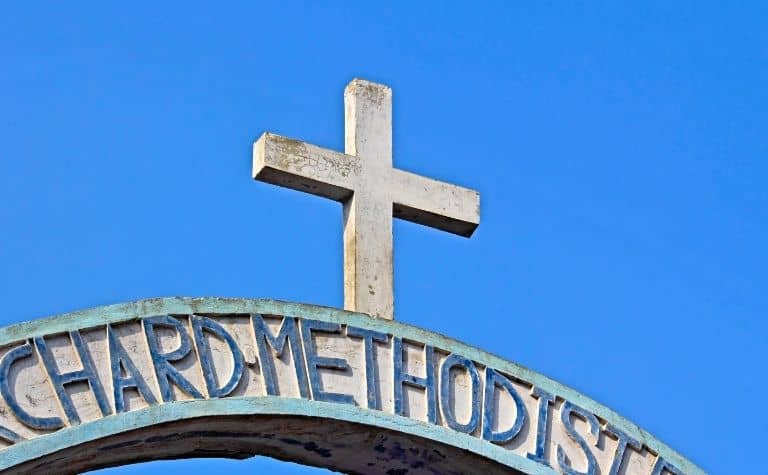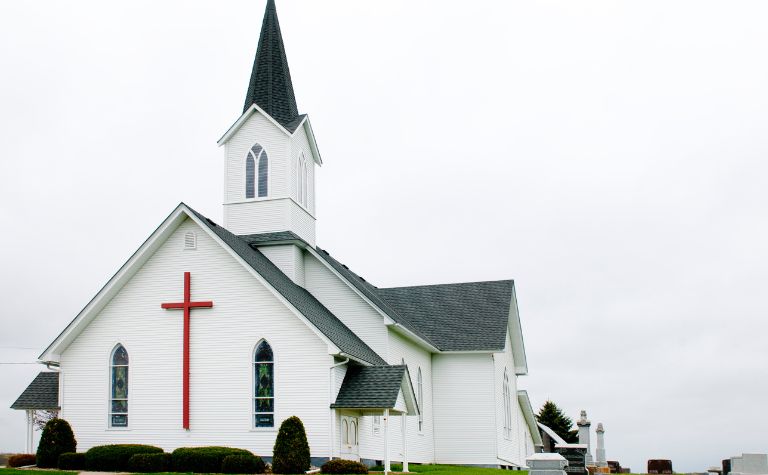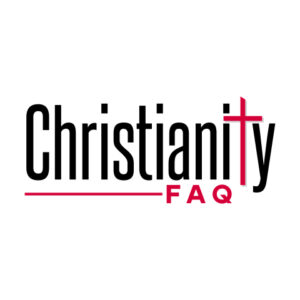The names “Methodist” and “Protestant” in Christianity describe similar people, beliefs, and practices. However, the terms are not synonyms because there are important differences between them.
The name “Protestant” refers to the reform movement started in the 16th century that challenged the alleged abuses and excesses of the Roman Catholic Church. “Methodist” describes a tradition within the Protestant movement that shares its core conviction but has certain unique views on secondary matters.
What is the same and what is different regarding the historical origins, core convictions, important literature, and worldview of Methodism and Protestantism? Do they believe the same about the inspiration of Scripture, the Trinity, the end times, and other doctrines? Keep reading to learn more.
Also, see Compare Protestant and Roman Catholic Churches to learn more.

Methodist vs. Protestant: Overview
All Methodist denominations and churches are Protestant. Not all Protestant churches are Methodist. Lutheran, Presbyterian, Baptist, Episcopal, and Assemblies of God denominations and churches are also Protestant. (Also, see Protestant vs. Reformed: What’s the Difference?)
All Protestant traditions share certain core convictions, like the inspiration of Scripture, the Trinity, and the deity of Christ.
Yet there can be many differences among Protestant traditions on matters like water baptism, the Lord’s Supper, the end times, baptism in the Holy Spirit, and who is eligible for membership and ordination. (Also, see Protestant vs. Pentecostal: What’s the Difference?)
| Methodism | Protestantism | |
|---|---|---|
| Origin | Born out of the 18th-century Pietist movement in the Anglican tradition (i.e., the Church of England), it ignited under the leadership of brothers John Wesley (1703-1791) and Charles Wesley (1707-1788). | 16th-century Europe, especially Germany under the reforms of Martin Luther (1483-1546); the Protestant Reformation is the trunk, and Methodism is one of its branches. |
| Meaning of the name | From the English word “method,” the name refers to what people at Oxford called the Wesley brothers and other like-minded believers who maintained a strict regimen of spiritual disciplines. However, the Methodist tradition is known for more than spiritual disciplines. | The word “Protestant” comes from the Latin word protestari, meaning “to bear witness.” |
| Early influencer | Isaac Watts (1674-1748), William Wilberforce (1759-1833) | Martin Luther, John Calvin of France (1509-1564), and Ulrich Zwingli of Switzerland (1484-1531) |
| Significant writing outside the Bible | The Apostles’ Creed, The Nicene Creed; Wesley edited the 39 Articles of Religion, removing the Calvinist teachings in it; he also edited the Book of Common Prayer after the Revolutionary War; the United Methodist Hymnal. | The Apostles Creed, the Nicene Creed; the writings and sermons of Martin Luther, especially the 95 Theses, Calvin’s The Institutes of the Christians Religion; many others. |
| Organization | The term “connectionalism” describes the network of relationships among Methodist churches. “Bishops” lead churches within the framework of Episcopalian polity, as opposed to presbyterian or congregational polity. | Protestant churches can be organized in different ways, such as congregationalism, presbyterianism, or episcopalianism. |
| What are the largest denominations in the tradition today? | United Methodist Church, African Methodist Episcopal Church, African Methodist Episcopal Zion Church | Southern Baptist Convention, the United Methodist Church, the Evangelical Lutheran Church of America, and the Assemblies of God (see more below) |
| Theological and Social worldview | It depends on the denomination. Many churches in the UMC denomination have adopted liberal perspectives on many social and theological issues in recent decades. Other smaller denominations maintain conservative positions, such as the Evangelical Methodist Church (EMC). | Protestants may be liberal or conservative theologically or socially. |
The Methodist tradition is comprised of several denominations. In the past, denominations have divided over a variety of issues, including theological matters and social issues such as slavery. (Also, see Protestant vs. Eastern Orthodox: What’s the Difference?)
When a group of churches or people within a denomination separate from their parent tradition, they commonly form a new denomination. Such historical disagreements and divisions are not unique to Methodism. The largest Methodist denominations are:
- The United Methodist Church; estimated membership: 7.6 million
- African Methodist Episcopal Church; estimated membership: 2.5 million
- African Methodist Episcopal Zion Church; estimated membership: 301,000
- Christian Methodist Episcopal Church; estimated membership: 291,000
- Free Methodist Church of North America; estimated membership: 110,000
This list does not include denominations that have historical roots in Methodism, such as Holiness churches, Pentecostal churches, and other charismatic traditions, like Calvary Chapel and Vineyard churches. (Also, see Protestant vs. Anglican: What’s the Difference?)
To see how the largest Methodist denominations compare to those in other Protestant traditions, see the Largest Denominations in America: The Top 100.

Methodist and Protestant: Comparison
Historically, the core convictions of Protestantism, like the authority of Scripture, are also the central beliefs of Methodism.
Where Methodism differs from other Protestant traditions is on non-essential matters of the faith. (Also, see Protestant vs. Non-Denominational: What’s the Difference?)
For example, theologically, Methodists are Arminians and not Calvinists like Presbyterians. Also, Methodists baptize infants as Presbyterians and Lutherans do, yet Baptists and Assemblies of God only baptize adults.
Some have alleged that in the 21st century, some Methodist denominations and churches have drifted away from the core convictions of Protestantism as they have embraced liberal and progressive convictions on a variety of issues. (Also, see Protestant vs. Evangelical: What’s the Difference?)
| Methodism | Protestantism | |
|---|---|---|
| View of the Bible | The Bible is inspired according to traditional Methodist teaching. Some conservative Methodist denominations in America accept and use the term “inerrancy,” which means that Scripture is without error. | One of the hallmarks of the Protestant tradition is the authority of Scripture over and above church tradition. Protestants historically believe in the inspiration and authority of Scripture. |
| View of God | Methodists believe in the Trinity. There is one God who exists in three persons. | Protestants believe in the Trinity; there is one God who exists in three persons. The Father, Son, and Holy Spirit are each fully divine. |
| View of Christ | Jesus of Nazareth is God in human flesh; he is 100% God and 100% man; he is the eternal second person of the Trinity. | Jesus is the second person of the Trinity. He is God in human flesh. He is 100% God and 100% man. Jesus was born of a virgin, lived a sinless life, died as an atonement for sin, and was physically resurrection on the third day. |
| View of Salvation | Christ’s death is for all people. Prevenient grace makes people aware of their sin and their need to repent. It also causes them to seek God and salvation in Christ. | Protestants believe that salvation is by grace through faith in Christ alone. |

| Methodism | Protestantism | |
|---|---|---|
| View of the Holy Spirit | The Holy Spirit is the third person of the Trinity. He is fully divine. The Spirit applies the salvation that the Father planned and that the Son earned for sinners. He bestows spiritual gifts on believers that they are to use for the edification of the Church. Some Protestants are Methodists who have Pentecostal convictions, and some don’t. | The Holy Spirit is the third person of the Trinity. He is fully divine. The Spirit applies the salvation that the Father planned and that the Son earned for sinners. He bestows spiritual gifts on believers that they are to use for the edification of the Church. Some Protestants are Pentecostal, and some aren’t. |
| View of the Lord’s Supper | The Second Coming of Christ is a primary doctrine; the millennium is understood according to Amillennial theology, meaning it interprets the 1,000-year period described in Revelation 20:1-6 figuratively and defines it as the time between Christ’s first and second coming (i.e., the Church Age) | Generally, Protestants believe the Lord’s Supper is a continual practice that Christ started before his death and resurrection. Protestants don’t agree about the nature of the bread and cup. |
| View of the Baptism | To many Methodists, infant baptism is an act of “prevenient grace,” embedding within them a desire to seek God and turn from sin. | Generally, Protestants believe baptism identifies a person with the death and resurrection of Christ (Rom. 6:3-5) and obedience to Christ. It also signifies their inclusion into the church community (Acts 2:38-47). Protestants do not agree about who (children or adults) should be baptized and how (sprinkling or immersion). |
| View of the end times | The Second Coming of Christ is a primary doctrine; the millennium is understood according to Amillennial theology, meaning it interprets the 1,000-year period described in Revelation 20:1-6 figuratively and defines it as the time between Christ’s first and second coming (i.e., the Church Age) | Protestant churches may be Premillennial, Postmillennial, or Amillennial. |
Also, see Protestant vs. Baptist: What’s the Difference?
Please see the related articles below.
References:
[1] Source
[2] Source
[3] Source
Related Questions
Catholic vs. Protestant vs. Orthodox: What's the Difference?
Roman Catholicism, Protestant Christianity, and the Eastern Orthodox Church are the three historical branches of the Christian religion. Each tradition traces its doctrines and practices to the New...
Protestantism and Eastern Orthodoxy are two of the three historical branches of the Christian faith, along with Roman Catholicism. Though the Orthodox tradition is approximately 500 years older than...
